|
Biking in West Africa, from Togo to Benin Six people, Five Bikes and
an by Hope Wall |
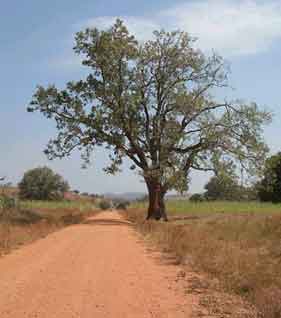 The road to Benin |
Hope lives in Baltimore, where she works as a nurse at Johns Hopkins Hospital. In her off hours she's a budding grassroots activist-community organizer and a recreational cyclist. She loves to travel, especially on the adventure/cultural immersion trips. I have always loved to travel to off the beaten path. But still, people ask me, why go to Africa, and why travel on a bike? I am never sure how to answer, wondering if I should convincingly describe the fascinations of travel by bicycle or if I should concentrate on the wonders of visiting Africa. Or should I resign myself to the possibility that many people choose to experience the world through the design of theme parks, on cruise ships or as members of an anonymous flock of tourists hurriedly visiting seven capital-cities in six nights from the confines of a tour bus and from I-could-be-anywhere hotels. Although how to answer those perplexing questions remains a struggle for me, with each new adventure I feel a little better equipped to at least influence people to become more adventurous. This bike trip to Africa was developed by a small responsible travel/eco-tourism organization in Seattle, Washington, called Bicycle Africa and also the International Bicycle Fund. The tours, as billed, are ideal for the realist who appreciates the world and the wonderful rewards gained through the modest rigors of bicycle touring. Though the questions can only really be answered through a first hand experience, I do my best by enthusiastically sharing my experiences and my hopes for future adventures. Six Americans, 36 to 57 years old, made this
trip. We gathered As we experienced time and time again, there were fairly easy solutions right at our fingertips. We found a street side bike 'mart' fairly close to the hotel. An eclectic array of several hundred bikes were lined up on a dusty lot, ranging from no gears up to twenty-one, and pretty much one size to fit everybody. We inspected several bikes closely, and after a test ride chose one equipped with a sturdy rear rack and a reasonably comfortable seat. The transaction required a moderate amount of serious but friendly bartering. Within 45 minutes, with our mission accomplished, we returned to the hotel, with a 33lb 21-speed mountain bike called the African Panther. An hour later we cycled off 10 miles to find transport for a 220 mile trip north to Sokode, where our cycling was to begin in earnest.
| |
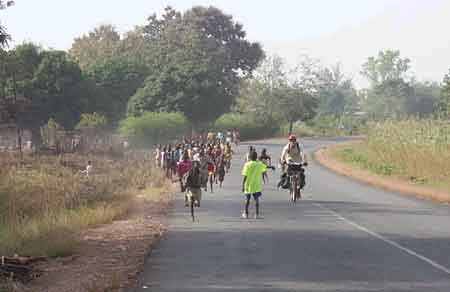 Here are some of those curious onlookers. | |
It is an understatement to say that six foreigners with loaded bikes would generate considerable  interest when rolling into a bus station. Instantly our group attracted a
small crowd of curious onlookers. Amid the flurry of activity, our leader
skillfully orchestrated the loading of our bikes and gear on top of the
reinforced van roof, with friendly direction from the crowd. After a brief
delay, and with a collection of local produce, breads and goodies we crammed
into the van and set out.
interest when rolling into a bus station. Instantly our group attracted a
small crowd of curious onlookers. Amid the flurry of activity, our leader
skillfully orchestrated the loading of our bikes and gear on top of the
reinforced van roof, with friendly direction from the crowd. After a brief
delay, and with a collection of local produce, breads and goodies we crammed
into the van and set out.
Togo and Benin are only 6 to 11 degrees north of the equator so the climate is warm to hot. Facing fairly hot and challenging midday temperatures, to maintain hydration and energy, we planned to start each day shortly after dawn, breakfasting at street side coffee tables, and setting out in the coolish morning temperatures. We cycled on the national highway at our own individual paces. Though it was a 'national highway' it had the traffic volume and character of a country road. Often local people would ride along with us for stretches, curious to find out where we were going. It struck me that a similar situation at home might feel quite unsettling. While in Africa it felt both comfortable and hospitable. It was a pleasure to have the company. Whenever my muscles shouted, "Give me a rest!" I would just glance at my companion's bicycle on the same incline and realize that he was riding a single speed bike, had no water bottles and didn't even seem to be breaking a sweat, and persevere.
| |
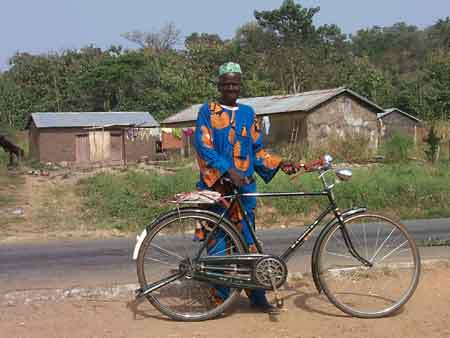 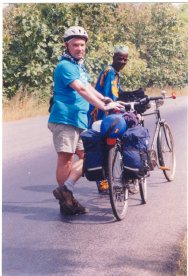 temporary traveling companions | |
Aside from the people and cultures, the appeal of traveling and bicycling in West Africa is, the landscape, the vegetation and the architecture. The terrain in Togo and Benin is essentially made up of rolling hills in the northern half, gradually flattening out toward the coast. The vegetation is variable from the drier grassland which are dotted with baobab trees to more lush verdant areas forested with palm oil, mango, citrus, eucalyptus and teak trees.
Each of us had stories to share at dinner about some form of aid or kindness they had received, the kind of experience that 'pays it forward'. It seemed no matter how remote we were, if we stopped for a repair a passerby would stop and offer to help. This was especially fortunate when the hot pavement eroded a patch of rubber on the African Panther's rear tire. Or if someone needed help a driver would drive on and notify those ahead. On day six we left the main road and cycled along a hard packed dirt road to cross the border into Benin. We were intrigued by the unique Tata Somba architectural style and the lifestyle and religion of the Tembera culture. We stopped at the dwelling of one family who offered to show us their home. Outside the home were various 'monuments', honoring their ancestors, a custom from the religion of animism.
Tata Somba house The size and degree of embellishment was relative to the importance of the ancestor it symbolized. On the first level of the home was an area to house some sheep and chickens. In a separate room on the same level was an area for both food preparation and the ladder to the second level. The open-air surface was an area used for drying grains, and on each corner of the structure were thatched sleeping rooms.
| |
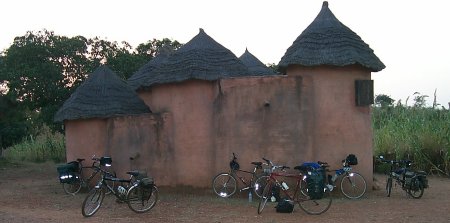 Tata Somba accommodation | |
|
I had been fascinated by these mini-castles in books, but here we were standing in them. No video or magazine can convey the incredible feeling of experiencing it with all five senses. Later, that same day, a very kind elder showed me into the village near his home, where people were busy pounding grains into flour, tending livestock, fetching water while children were playing, so different from the picture the media paints for us. Here was an established and highly functioning community operating without even a hint of the 'high technology' that we are so heavily reliant on. Peoples' needs were met, extended families were intact, and their lifestyles seemed to prove that the complexities we impose on ourselves don't necessarily make life easier or more fulfilling.
More cycling and another motor trip took us to Abomey, the historic capital of the often warlike Dahomey Kingdom. We toured the museum, housed in the partially restored original enclave. Janvier, an English speaking guide, lead us through the museum and surrounding structures. He explained the use of and production of the Benin 'story cloth' which chronicles the past rulers of the Kingdom. He also spoke of the impact of the European slave traders and also of their own participation in the acquisition of human trade, and the lifestyle of the royalty. Planned discussions reinforced and expanded on what we had learned. By this time it was day nine of our trip. We cycled onward to Ouidah, via Lakossa. The countryside was leveling out and the temperature and humidity were less challenging. There seemed to be more markets around filled of all sorts of fresh produce. There were pineapples that weighed close to twelve pounds and ripe ready to eat mangoes. To me this was heaven. Between the fresh fruit and the best ever peanuts I had no use for the high-energy nutritional supplements I had brought along, and they were a whole lot cheaper.
The next town was Ouidah, a port on the Gold Coast of Africa with a long and brutal history of slave trading. We visited the museum, which was once a Portuguese slave fortress. It was one of five that existed at various times in the town. Among the artifacts were some shackles used to secure the captives. To actually see this first hand made those dark words in our history books come alive and seem even more disturbing. Though humbled by those visions and emotions, little can match the feeling of seeing the monument that had been erected signifying the point of no return where the human cargo was loaded onto the ships. The last two days were flat, fairly fast coastal rides that carried us back across into Togo ending up in Lome, where sadly the trip had to end. In total we had cycled about 450 miles and driven about three hundred miles. Though the African Panther had performed well and had developed a great deal of sentimental value it was better, and less cumbersome to leave it in Lome. And besides, Karen's bike turned up at the airport half way through the trip. We had seen, experienced and learned so much. Each of us took home a different but unique set of memories, and we are all, no doubt, richer as human beings for having had this experience. And the African Panther is one symbol that comes to mind when I try to answer the question: Why Africa? If you've got a question or some comments for Hope, email her at hopetogo2000 @yahoo.com (remove space) | |
| Copyright © 2001 Hope Wall. All rights reserved. | |
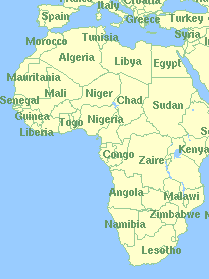 at a small hotel in Lome, the seaside capital city of Togo,
where our journey began. This one was a two-week self-contained bicycle tour
through Togo and Benin, West Africa. At the start one minor problem kept us
from setting off bright and early. One of the bikes had not been forwarded
on the flight to Paris, so that when Karen arrived in Africa she was faced
with three options: return home; follow along with the group using local
transport; or buy a bike.
at a small hotel in Lome, the seaside capital city of Togo,
where our journey began. This one was a two-week self-contained bicycle tour
through Togo and Benin, West Africa. At the start one minor problem kept us
from setting off bright and early. One of the bikes had not been forwarded
on the flight to Paris, so that when Karen arrived in Africa she was faced
with three options: return home; follow along with the group using local
transport; or buy a bike.  At
regular intervals from the road we could see the eclectic architecture of
small villages, some of which is unique to the area. At times we
would stop to enjoy the sites, or search for sustenance. Each time we stopped
at a village pump to fill our water bottles, bystanders would offer to pump
our water. The hospitality and selfless willingness to help is difficult to
describe. Our culture tends to monetize such situations but there it wasn't
appropriate, and if anything may have set up an expectation that other
travelers would do the same.
At
regular intervals from the road we could see the eclectic architecture of
small villages, some of which is unique to the area. At times we
would stop to enjoy the sites, or search for sustenance. Each time we stopped
at a village pump to fill our water bottles, bystanders would offer to pump
our water. The hospitality and selfless willingness to help is difficult to
describe. Our culture tends to monetize such situations but there it wasn't
appropriate, and if anything may have set up an expectation that other
travelers would do the same.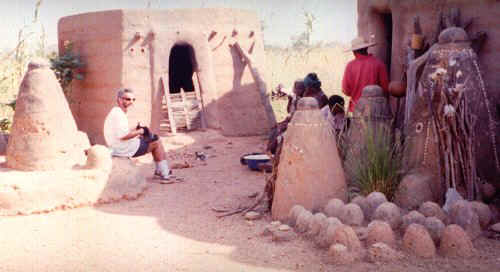
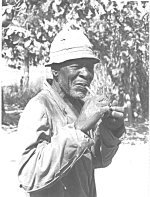 It was also the kind of experience that made me evaluate my notion of
poverty and of wealth and begin to understand the difference between needing
and wanting. The lesson in simplicity made the accommodation that night just
about perfect. We were housed in a Tata Somba dwelling where we slept on foam
mattresses on the outdoor open area on the second level under the light of
the full moon.
It was also the kind of experience that made me evaluate my notion of
poverty and of wealth and begin to understand the difference between needing
and wanting. The lesson in simplicity made the accommodation that night just
about perfect. We were housed in a Tata Somba dwelling where we slept on foam
mattresses on the outdoor open area on the second level under the light of
the full moon.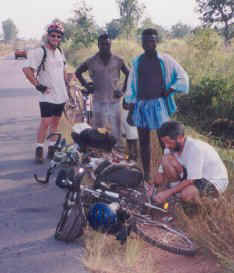 By this time almost everyone had had some sort of mechanical failure or
flat tire. Some people had high end, expensive bikes, while others had real
plain no frills kinds of bikes. And the African Panther had functioned as
well as any of the other bikes, albeit slower because of its weight.
By this time almost everyone had had some sort of mechanical failure or
flat tire. Some people had high end, expensive bikes, while others had real
plain no frills kinds of bikes. And the African Panther had functioned as
well as any of the other bikes, albeit slower because of its weight.